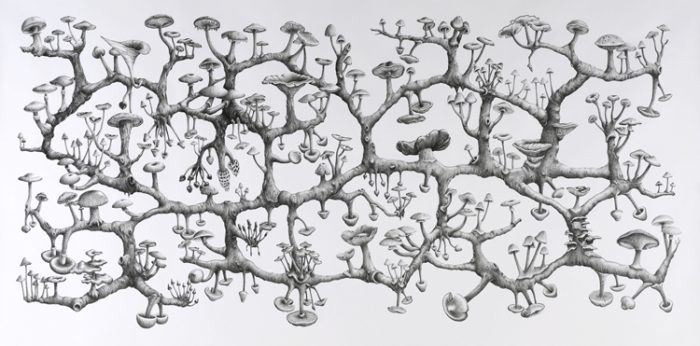A Network of notes is a rhizome not a tree

The Zettelkasten is not just an outline
The Zettelkasten approach to making notes and writing is not the same as creating a standard outline. An outline is basically linear and hierarchical. It’s a tree-like structure. It’s ‘arborescent’. The Zettelkasten on the other hand is a non-linear, non-hierarchical network, that includes hierarchical and linear structures, but is not bound by them. The Zettelkasten is more like a ‘rhizomatic’ structure. It has many connections, but no obvious central trunk. It’s like ginger.
The Zettelkasten can include outlines
The process of writing an article or book might well involve preparing an outline (e.g. a table of contents), but this is done from the contents of the Zettelkasten, not directly by the Zettelkasten itself. The idea is for the Zettelkasten to maintain a more fluid structure than a hierarchical outline, to allow idea formation, prior to the composition of a tightly-structured argument. I do have tables of contents, structure notes, ‘maps of content’, hubs, indices, etc. within my Zettelkasten, but ultimately each of these is just another note in the wider network.
Notes connect in several different ways
Links can connect notes in all kinds of directions. Niklas Luhmann emphasised this possibility of referral [Verweisungsmöglichkeiten]:
“When there are multiple options you can solve the problem by placing the note wherever you want and create references to capture other possible contexts.” - Luhmann, Communication with Zettelkasten
Consider too Daniel Lüdecke’s presentation on Zettelkasten structure PDF. This clearly shows what Luhmann did and didn’t do (according to Lüdecke at least - see especially slide 31 or thereabouts).
Avoid premature closure
A finished piece of work such as a book or article is fixed. Its structure is basically final. This is not true of your notes. They are still fluid, still open to shuffling and re-shuffling. The Zettelkasten’s adaptive structure is confirmed by Schmidt’s summary:
“At first glance, Luhmann’s organization of his collection appears to lack any clear order; it even seems chaotic. However, this was a deliberate choice. It was Luhmann’s intention to “avoid premature systematization and closure and maintain openness toward the future”. A prerequisite for a creative filing system, Luhmann noted, is “avoiding a fixed system of order”. He pinpoints the disadvantages that come with one of the common systems of organizing content in the following words: “Defining a system of contents (resembling a book’s table of contents) would imply committing to a specific sequence once and for all (for decades to come!)”. His way of organizing the collection, by contrast, allows for it to continuously adapt to the evolution of his thinking.” - Johannes F.K. Schmidt. ‘Niklas Luhmann’s Card Index: Thinking Tool, Communication Partner, Publication Machine’, in Cevolini, Alberto.; Forgetting Machines : Knowledge Management Evolution in Early Modern Europe. Brill, 2016. Ch. 12, p. 300. PDF
A disclaimer
Your mileage may vary. When turning your note-work into a network, do what works for you, not what worked for a dead German sociologist.
See also:
- The search for interconnection
- How to be interested in everything
- Thoughts are nest-eggs
- Serious about a Zettelkasten?
- The card index has triumphed
- We can’t master knowledge
- Deleuze, Gilles and Félix Guattari (2004/1980). Rhizome. In A Thousand Plateaus: Capitalism and Schizophrenia, trans. Brian Massumi. New York: Continuum, pp. 3-28.